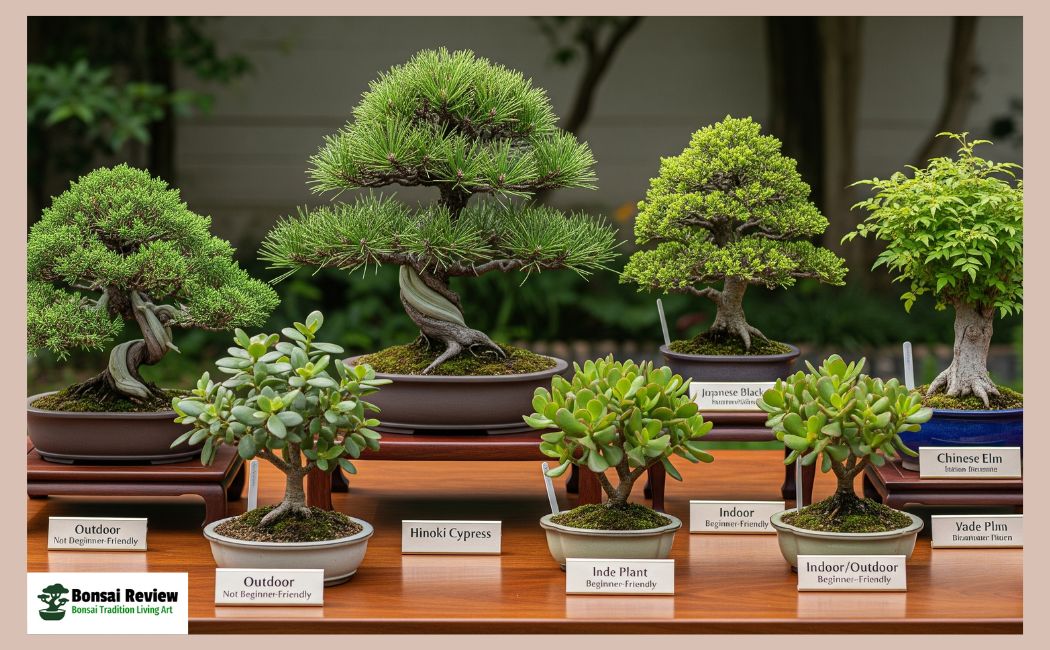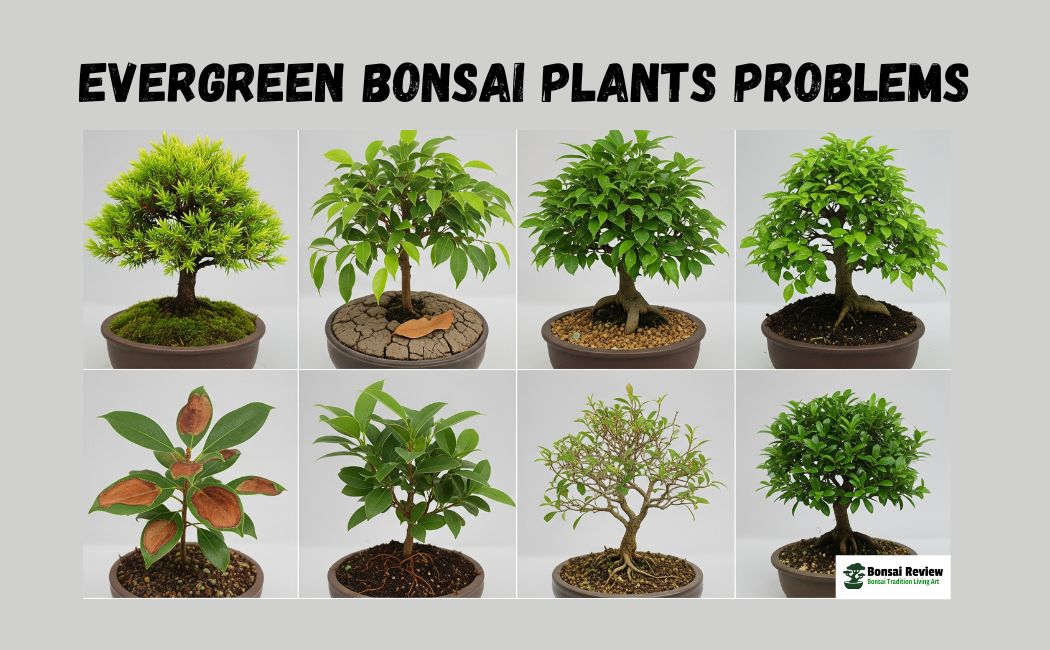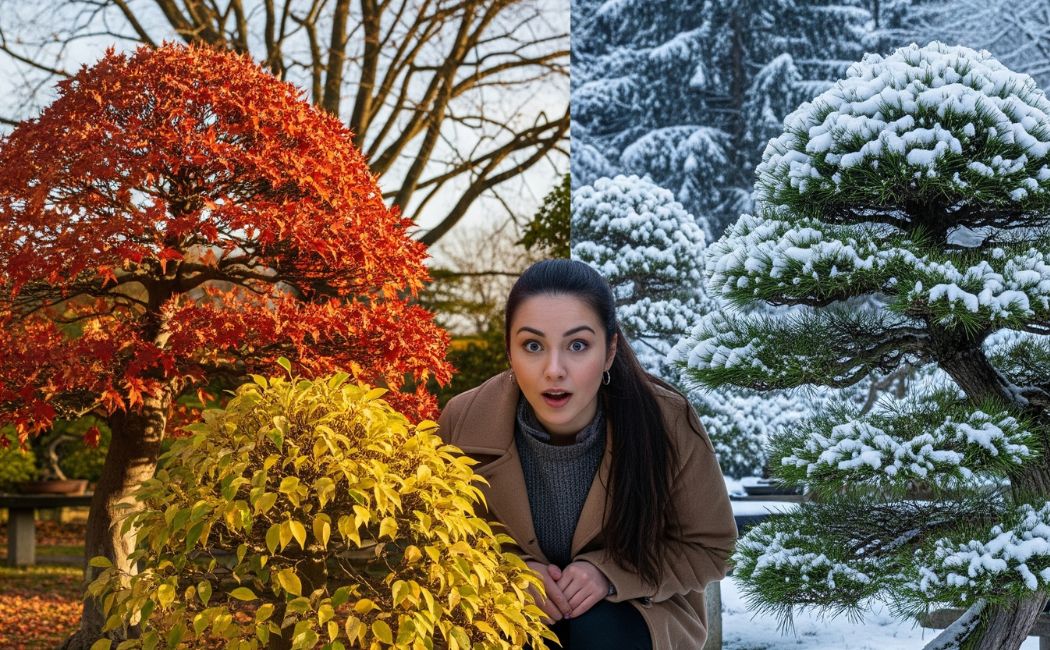Evergreen bonsai plants come in a variety of colors, of course, green, but also red, brown, or yellow. They may at times lose their needles and generally have a pleasant aroma.
Do you love the look of a bonsai tree but worry that the leaves will turn brown and fall every winter? Juniper, cedar, pine, and cypress indoor dwarf plants and outdoor trees are conifers, never losing their leaves and remaining green year-round.
Many trees lose their color and look bare in the cold season. That is where the evergreen bonsai plant comes in. This little tree stays green in every season. It keeps its beauty in summer, fall, and even in winter.
You can choose from many evergreen bonsai types. A juniper like Juniperus chinensis ‘Itoigawa’ is strong and easy to shape. A Japanese black pine or white pine gives you long needles and a bold look.
A Hinoki cypress ‘Tsue’ or Alberta spruce grows neat and compact. If you want an indoor bonsai tree, a ficus microcarpa, jade plant, or even a fig tree is a good choice.
For softer leaves, you may like a Chinese elm. Each one has its charm, whether you prefer small starter trees or large show trees.
Today, you can find these bonsai for sale online, at a nearby nursery, or even in DIY kits. Some are listed on sale, so you can pick the right price for your budget. You will also see bonsai in many styles.
Some with black pine needles, some with white tips, and some glossy like ficus leaves. If you only want the look, you can even buy artificial flora bonsai that stays bright without care.
With so many choices, your problem is no longer losing green in winter. Your new question is: Which evergreen bonsai is best for you, and how do you care for it?

What Makes an Evergreen Bonsai Special?
When you pick an evergreen bonsai plant, you are choosing a tree that never loses its leaves. Unlike a Japanese maple or other deciduous bonsai that turn red or yellow and drop leaves in autumn, an evergreen keeps its green color all year. That means your bonsai always looks alive, fresh, and full.
There are two main groups of evergreen bonsai:
- Conifer bonsai trees with needles or scale-like leaves. This includes juniper, pine, spruce, and cedar. Conifers are loved for their strong look and long life. A black pine feels bold, while a white pine feels soft and elegant.
- Broadleaf evergreen bonsai trees with flat leaves that never fall. This group includes ficus microcarpa, boxwood, Japanese holly, jade plant, and fig trees. These are often good choices for indoor bonsai trees, since they handle lower light better.
An evergreen bonsai also brings meaning. In many cultures, it is seen as a symbol of strength, balance, and eternal life. People place them in homes, gardens, or even offices to bring peace and focus.
So, if you want a bonsai that gives you beauty in every season, while carrying deep meaning, an evergreen bonsai is the right pick for you.

Different Types of Evergreen Bonsai Plants You Can Grow
You have many choices when it comes to an evergreen bonsai plant. Some are better for outdoors, like junipers and pines, while others, such as ficus microcarpa or jade plants, grow well indoors. Here’s a quick guide:
| Bonsai Tree Type | Leaf/Needle Type | Indoor / Outdoor | Beginner Friendly? | Special Notes |
| Juniper (Juniperus chinensis ‘Itoigawa’) | Scale-like green needles | Outdoor | Yes | Hardy, classic, easy to shape |
| Japanese Black Pine (Pinus thunbergii) | Long, stiff dark needles | Outdoor | Medium | Bold, strong look, long life |
| Japanese White Pine (Pinus parviflora) | Soft, fine needles | Outdoor | Medium | Elegant, loved in Japan |
| Hinoki Cypress ‘Tsue’ (Chamaecyparis obtusa) | Flat, glossy green fans | Outdoor | Medium | Neat growth, from Japan |
| Alberta Spruce | Short, dense needles | Outdoor | Yes | Compact, slow-growing |
| Ficus microcarpa | Glossy oval leaves | Indoor | Yes | Great for beginners, easy indoor care |
| Jade Plant (Crassula ovata) | Thick, shiny leaves | Indoor | Yes | Drought-tolerant, simple to prune |
| Chinese Elm | Small serrated leaves | Indoor/Outdoor | Yes | Semi-evergreen, tough tree |
| Fig Trees (Ficus carica) | Broad green leaves | Indoor | Medium | Needs warmth, looks soft and natural |
| Japanese Holly (Ilex crenata) | Tiny, round, dark leaves | Outdoor | Medium | Neat shape, strong evergreen |
| Boxwood (Buxus microphylla) | Small, dense leaves | Outdoor | Yes | Good for shaping, classic bonsai shrub |

Which Evergreen Bonsai is Best for Beginners?
If you are just starting your bonsai journey, you need a tree that is simple to care for, strong, and forgiving. Some evergreen bonsai trees can be tricky, but a few are perfect for beginners.
- Juniper (Juniperus chinensis ‘Itoigawa’): This is the most popular starter bonsai. It grows well outdoors, stays green all year, and looks good in both small and large sizes. You can often find juniper bonsai for sale online at a fair price.
- Ficus microcarpa: A top choice for an indoor bonsai tree. The Ficus Microcarpa dwarf plant has glossy green leaves, adapts to low light, and grows quickly. You can prune it often without harm.
- Jade Plant (Crassula ovata): Known as the “money tree,” jade is almost unbreakable. It stores water in its thick leaves, so even if you forget to water, it will survive. A great choice if you want low-effort care.
- Chinese Elm: A tough tree that can grow both indoors and outdoors. Its small leaves make it look like a miniature forest. It is semi-evergreen, but in warmer zones, it keeps its green color all year.
If you are new, start with a small bonsai tree. It is cheaper, easier to shape, and you can learn before moving on to a large bonsai. Many nurseries also sell beginner sets or DIY bonsai kits, so you can practice step by step.

How to Care for Evergreen Bonsai Plants?
Caring for an evergreen bonsai plant is not hard once you know the basics. Your tree can live for many years if you give it the right light, water, soil, and care.
1. Light Needs
Most evergreen bonsai trees, like junipers, pines, and spruce, need full sun outdoors. Place them where they get at least 6 hours of light daily.
Indoor species like Ficus microcarpa and jade plant prefer bright windows or grow lights.
2. Watering Rules
A bonsai tree must never dry out fully, but it also must not sit in water.
- Small bonsai: dry faster and need more frequent watering.
- Large bonsai: hold moisture longer, so check the soil before watering.
- A good rule: water when the topsoil feels slightly dry.
3. Soil & Repotting
Evergreen bonsai need free-draining soil. Many nurseries sell ready bonsai mixes, or you can DIY soil using akadama, pumice, and lava rock. Repot every 2–3 years to keep roots healthy.
4. Pruning & Shaping
Prune back long shoots to keep a compact shape. Use clean bonsai scissors for a neat cut. Wiring branches is common with juniper bonsai, but be gentle with softer trees like ficus.
5. Winter Care
If you live in Zone 7 or colder, protect outdoor bonsai like pines, spruces, and junipers. Place them in a cold frame, unheated shed, or wrap the pot with straw. Indoor bonsai should be kept away from cold drafts.
6. Fertilizer
Feed your bonsai during spring and summer with a balanced liquid feed. Reduce feeding in the fall, and stop in winter when growth slows.

Where to Buy Evergreen Bonsai Plants
Once you know which evergreen bonsai plant is right for you, the next step is finding one to bring home. Your Evergreen Bonsai Beauty That Lasts All Year. You have several options:
1. Online Bonsai Stores:
You can buy bonsai trees online from trusted nurseries like:
- Bonsai Boy: outdoor and indoor evergreens like juniper, pines, and cypress.
- Eastern Leaf: offers species such as Ficus microcarpa, Alberta spruce, and juniper.
- David Cheshire Nurseries: specialty bonsai, including Hinoki cypress ‘Tsue’.
- Herons Bonsai: a wide selection for indoor and outdoor bonsai.
Tips for online buying:
- Check the size (small vs large).
- Look at images for leaf health and branch structure.
- Compare prices and see if trees are on sale.
- Read reviews to ensure the tree is healthy and shipped well.
2. Nearby Nurseries or Bonsai Clubs
Visiting a local nursery lets you see the tree before buying. You can feel the size, shape, and leaf color, which is helpful if you want a small beginner bonsai or a large display tree. Local bonsai clubs sometimes sell trees and offer guidance on zone 7 winter care and bonsai maintenance.
3. DIY Bonsai Kits & Artificial Options
For beginners or hobbyists, DIY bonsai kits give you everything to start shaping your evergreen bonsai. Some kits even include artificial flora bonsai, which is perfect if you want the look of green without watering or pruning.
Quick Advice Evergreen Bonsai Plant: If you choose juniper, ficus microcarpa, or jade plant, buying from a trusted source ensures your bonsai starts healthy and grows strong.

Common Evergreen Bonsai Problems & How to Fix Them?
Even though evergreen bonsai plants are hardy, beginners sometimes face a few common problems. Knowing how to fix them will keep your bonsai green and healthy all year.
1. Yellowing Leaves or Needles
- Cause: Overwatering or poor drainage.
- Fix: Check the soil; it should drain well. Water only when the top layer is slightly dry. Species like juniper, pine, and ficus microcarpa need balanced watering.
2. Brown Tips or Leaf Edges
- Cause: Low humidity or too much sun.
- Fix: For indoor bonsai like jade plant or ficus, mist the leaves occasionally. Move outdoor bonsai like Alberta spruce to partial shade during very hot days.
3. Dropping Foliage
- Cause: Poor light, sudden temperature changes, or stress during repotting.
- Solution: Ensure your bonsai tree receives sufficient sunlight. Junipers need 6–8 hours of sun; indoor species like ficus prefer bright window light. Avoid moving the tree frequently.
4. Pests & Diseases
- Cause: Aphids, spider mites, or fungal infections.
- Fix: Inspect leaves regularly. Spray juniper, pine, or broadleaf bonsai with a mild insecticide if needed. Remove dead leaves and prune carefully.
5. DIY & Artificial Flora Alternative
- If you want the look of green without worrying about care, artificial bonsai is an option. Perfect for offices or décor where regular watering isn’t possible.
Tip for Evergreen Bonsai Plants: Most problems happen when a bonsai is new to your care routine. Observe your tree daily, learn its needs, and adjust watering, light, and pruning as needed.

Conclusion: Why Are Juniper, Ficus, and Jade Bonsai So Popular for Beginners?
Choosing an evergreen bonsai plant solves a common problem having a bonsai tree that loses its leaves in winter. With species like juniper, ficus microcarpa, jade plant, Chinese elm, Japanese black pine, and Hinoki cypress ‘Tsue’, you can enjoy green leaves all year long.
By understanding evergreen bonsai types, easy-care species, and how to water, prune, and protect your bonsai, you can confidently grow your tree indoors or outdoors. Whether you pick a small bonsai for your desk or a large display bonsai for your garden, there’s a perfect option for every beginner.
You can find bonsai trees for sale online or at a nearby nursery, sometimes on sale or in DIY kits. If you want the look of green without the care, artificial bonsai is also available.
Start small, choose the right evergreen bonsai, and enjoy a living piece of nature and art in your home all year round. Your tree will not only stay beautiful but also bring peace, balance, and a sense of accomplishment every day.
Helpful article: Ultimate Guide to Bonsai Tree Care: Dos and Don’ts!
FAQs: Why an Evergreen Bonsai Plant is Your All-Year Green Friend?
1. Can evergreen bonsai live indoors?
Yes! Species like ficus microcarpa, jade plant, and fig trees grow well indoors. Make sure they get bright light near a window or use a grow light.
2. Which evergreen bonsai is easiest to grow?
For beginners who love bonsai, juniper (Juniperus chinensis ‘Itoigawa’), Ficus microcarpa, jade plant, and Chinese elm are the easiest. They tolerate mistakes in watering and pruning.
3. Do evergreen bonsai stay green all year?
Most do, but it depends on the species. Conifer evergreens like junipers, pines, and spruce stay green outdoors. Broadleaf evergreens like ficus stay green indoors with proper light.
4. What is the price range for evergreen bonsai trees?
Prices vary by species, size, and age. Small bonsai for beginners can cost less, while large show trees like Hinoki cypress ‘Tsue’ or Japanese black pine cost more. Many stores offer bonsai trees for sale online and on sale.
5. How do I care for my bonsai in Zone 7?
Evergreen bonsai plant in Zone 7. Outdoor bonsai, like juniper, pine, and spruce, need winter protection. Indoor bonsai, like Ficus Microcarpa or jade plant, can stay inside during cold months.
6. Are there artificial bonsai options?
Yes! Artificial flora bonsai looks like a real evergreen bonsai plant, but doesn’t need watering, pruning, or light. Perfect for offices or décor lovers.
7. Do bonsai trees lose all their leaves in winter?
If you have a deciduous variety of bonsai, then the bonsai will drop all of its leaves over winter. This is a wonderful time to admire and truly appreciate the trunk and branch structure of your bonsai.
8. Are juniper bonsai evergreen?
The Juniper Bonsai tree (Juniperus). The juniper genus is made up of about 50 to 70 different species within the cypress family. They are evergreen coniferous trees or shrubs, which are very popular for indoor and outdoor bonsai plants.